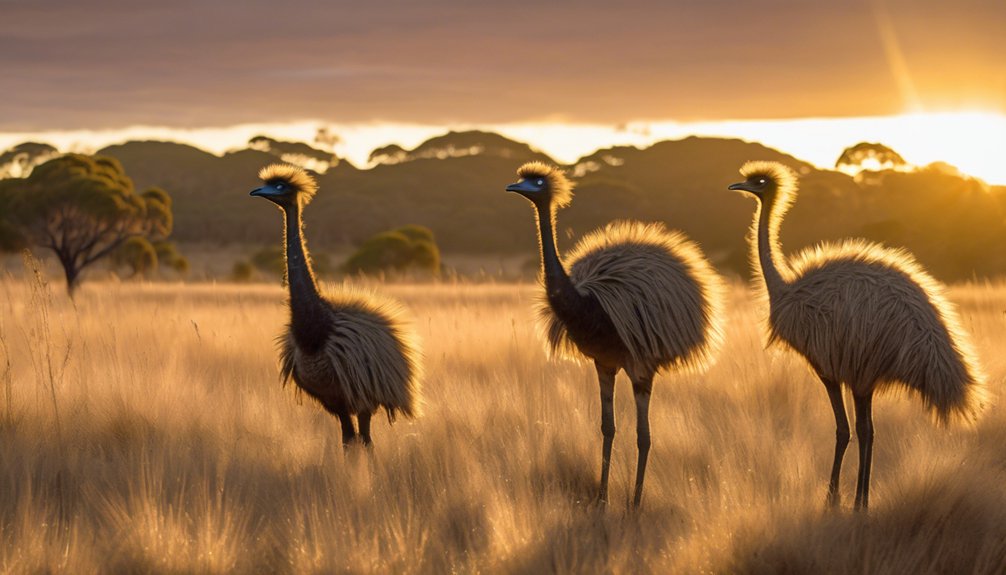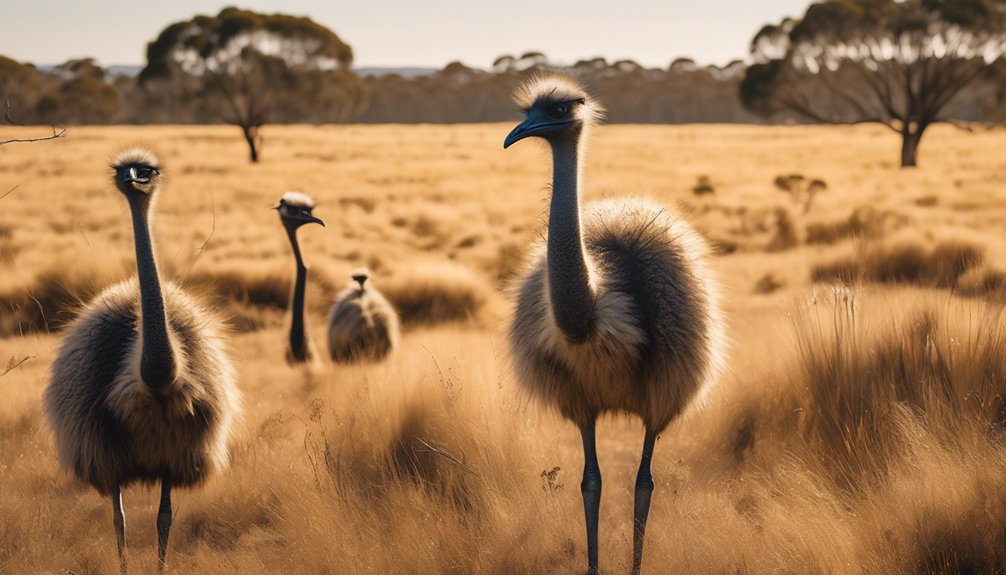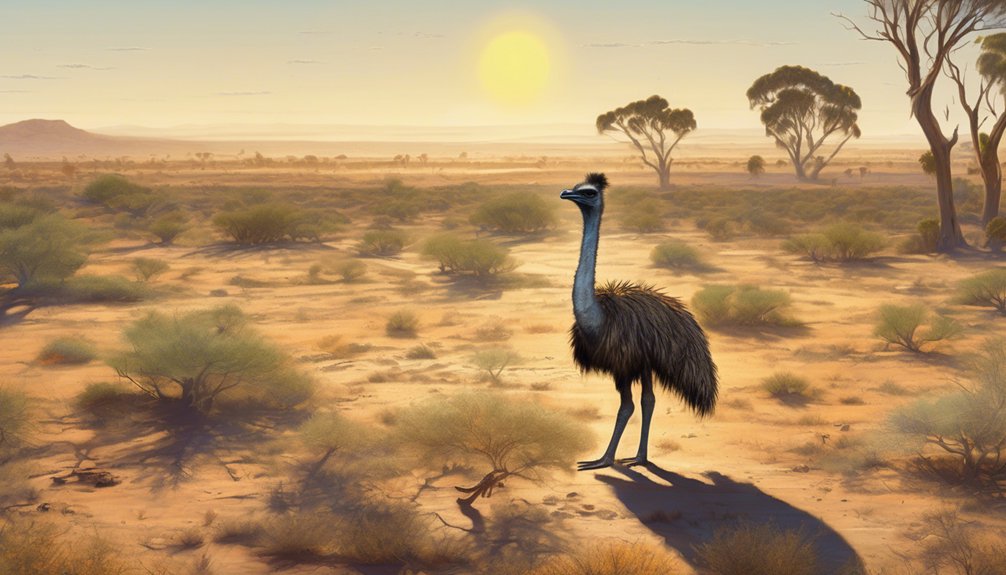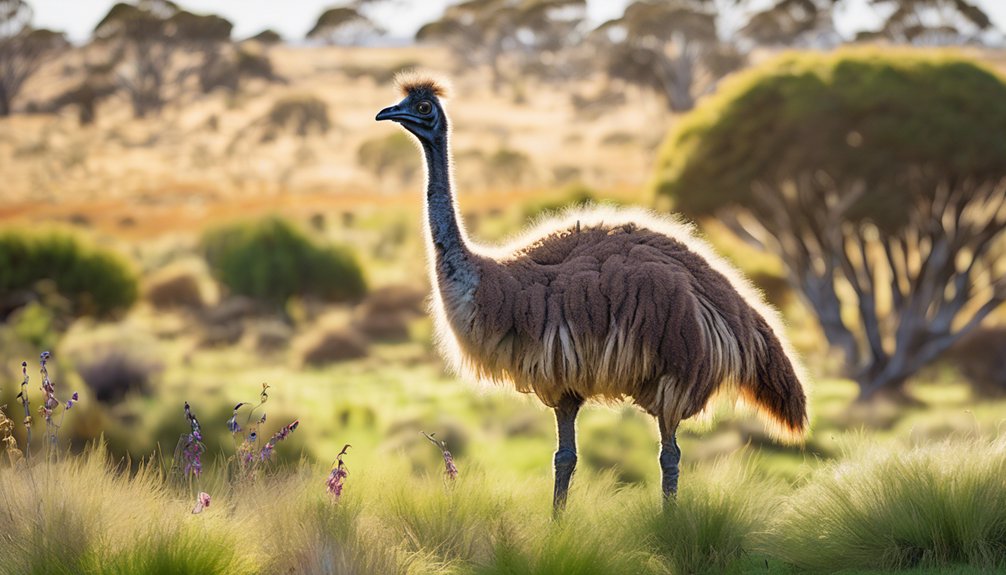
Emu conservation plays a crucial role in maintaining Australia's biodiversity. These flightless birds are not just iconic; they serve vital ecological functions, such as seed dispersal. However, their populations face significant threats, including habitat loss and climate change. Understanding these challenges is essential for effective conservation strategies. What are the specific actions being taken to protect emus, and how can you contribute to these efforts? The answers might surprise you.
Key Takeaways
- Emu populations face threats from habitat loss, urban development, and competition from invasive species, necessitating urgent conservation measures.
- Conservation efforts include habitat preservation, ensuring safe environments for emus to thrive and breed.
- Community engagement initiatives promote collaboration between residents and conservationists to protect emus and their habitats.
- Public education programs enhance awareness about emus' ecological role and the importance of their conservation.
- Research initiatives inform strategies for predator control and management, supporting emu population recovery efforts.
Overview of Emu Populations in Australia

Emus, Australia's iconic flightless birds, number in the millions across the continent, making them one of the most abundant native species. Their emu distribution spans diverse habitats, from coastal regions to arid outback areas.
Understanding their population trends is crucial for conservation efforts. Despite stable numbers overall, localized declines occur due to habitat loss and human encroachment. In certain regions, you might notice fluctuations, often linked to seasonal changes and food availability.
By keeping track of these trends, you gain insight into broader ecological shifts impacting the emus. Engaging with local conservation initiatives can deepen your connection to these remarkable birds and help ensure they thrive for generations to come.
Your awareness and action can truly make a difference in their future.
The Ecological Role of Emus
Understanding the population dynamics of emus reveals their significant ecological role within Australian ecosystems. These remarkable birds engage in various behaviors and interactions that enhance biodiversity. For instance, they help disperse seeds through their foraging habits, promoting plant growth and regeneration.
Their unique grazing patterns also influence vegetation structure, which benefits other species.
- Emus create habitats for smaller animals by breaking down dense vegetation.
- Their presence attracts predators, thereby balancing the food web.
- Emu interactions with other wildlife foster a diverse ecosystem.
Cultural Significance of Emus to Indigenous Australians

While many may overlook their importance, emus hold a deep cultural significance for Indigenous Australians that transcends mere ecological value.
These magnificent birds appear in numerous cultural stories, embodying lessons of resilience and survival. For many communities, emus are more than a food source; they're integral to traditional hunting practices, often symbolizing a connection to the land and ancestors.
The act of hunting emus is steeped in ritual, fostering communal bonds and imparting knowledge to younger generations. Through these traditions, emus not only sustain diets but also enrich cultural identity, weaving a rich tapestry of heritage.
As you learn about their significance, you'll appreciate how emus embody the spirit of Australia's Indigenous peoples, reminding us of the interdependence between nature and culture.
Threats Facing Emu Populations
As habitat loss increasingly threatens emu populations, it's crucial to recognize the multifaceted challenges they face. One of the significant issues is habitat fragmentation, which disrupts their natural movement and breeding patterns.
Additionally, poaching threats have emerged as a stark reality, putting further pressure on these majestic birds.
You mightn't realize how these issues intertwine with the emus' survival, but they do. Consider the implications:
- Loss of safe nesting areas due to urban development.
- Increased competition for food from invasive species.
- Direct harm from unregulated hunting and poaching.
Addressing these challenges requires a concerted effort from all of us, ensuring emus continue to thrive in their native habitats.
Together, we can advocate for their protection.
Habitat Loss and Its Impact

Habitat loss significantly impacts emu populations, leading to a cascade of ecological consequences. Urban development and agricultural expansion are two primary drivers of this loss, fragmenting the habitats emus rely on for food and nesting. As you contemplate these changes, realize that every lost habitat affects not just emus, but the entire ecosystem.
| Cause | Impact on Emus |
|---|---|
| Urban Development | Habitat fragmentation |
| Agricultural Expansion | Reduced food sources |
| Deforestation | Nesting site loss |
| Pollution | Health decline |
| Climate Alteration | Increased stress |
Understanding these connections helps you appreciate the urgency of conservation efforts. Protecting emu habitats means safeguarding the intricate web of life they support.
Climate Change Effects on Emus
Climate change poses a significant threat to emus, affecting their survival and adaptability in increasingly unpredictable environments. As temperatures rise and weather patterns shift, emus face challenges that test their capacity for climate adaptation strategies.
You might wonder how these birds cope with such changes.
- Emus need to develop temperature resilience to thrive in hotter climates.
- Altered food availability impacts their nutrition and breeding success.
- Habitat fragmentation limits their ability to move to more suitable environments.
Invasive Species and Predation

Rising temperatures and changing weather patterns aren't the only challenges emus face; invasive species and predation significantly threaten their populations.
In Australia, feral cats and foxes are primary predators, preying on emu chicks and eggs. Their presence complicates predator management efforts, as these invasive species disrupt the natural balance.
You mightn't realize how each introduced species can amplify predation risk, making it crucial to address this issue. Effective predator management strategies, like trapping and habitat restoration, are essential to safeguard emus.
Current Conservation Efforts
While many challenges threaten emus, current conservation efforts focus on mitigating these risks and enhancing their populations.
These initiatives rely heavily on community engagement, fostering collaboration between local residents and conservationists. You're likely to see programs aimed at educating the public, which helps create a sense of responsibility toward these magnificent birds.
Additionally, conservation funding is crucial for habitat restoration and protection projects.
Here are some key efforts underway:
- Habitat preservation: Ensuring emus have safe spaces to thrive.
- Predator control: Implementing measures to reduce threats from invasive species.
- Research initiatives: Gathering data to inform conservation strategies.
Together, these efforts not only protect emus but also strengthen the bond between communities and their native wildlife.
How Individuals Can Help Emu Conservation

How can you make a meaningful impact on emu conservation? Start by engaging in community involvement. Join local conservation groups or volunteer at wildlife sanctuaries focused on emus.
These organizations often host educational programs that raise awareness about emus and their habitats. By participating, you not only gain knowledge but also help spread the word.
Consider adopting sustainable practices in your daily life, like reducing plastic use and supporting eco-friendly products. Every small action counts.
Share what you learn through social media or community events, inspiring others to join the cause. Finally, donate to emu conservation projects or advocate for policies that protect their environment.
Your efforts can create a ripple effect, fostering a deeper understanding and commitment to preserving these unique birds.
Frequently Asked Questions
What Is the Lifespan of an Emu in the Wild?
In the wild, emus typically exhibit a lifespan of 10 to 20 years. Their longevity hinges on factors like habitat quality and predation risks, impacting survival strategies that you can observe during their daily activities.
Do Emus Migrate or Stay in One Area?
Emus display fascinating behavior; they don't migrate but instead adapt to seasonal patterns, often roaming within a defined range for food and water. You'll find them staying close to familiar environments, showcasing their resilient nature.
How Fast Can Emus Run?
Emus can run at speeds up to 30 miles per hour. As flightless birds, they rely on their powerful legs for swift movement, enabling them to cover large distances quickly in search of food or safety.
What Do Emus Eat in Their Natural Habitat?
Imagine watching an emu foraging through the bush, pecking at seeds and fruits. Their diverse diet includes grasses and insects, showcasing their natural foraging skills, which reflect the adaptability of their emu diet in the wild.
Are Emus Endangered or Threatened?
Emus aren't currently classified as endangered, but their populations face threats. You'll find that ongoing conservation efforts aim to protect their habitats and ensure their survival, highlighting the importance of awareness and action in preserving these iconic birds.
Conclusion
In safeguarding emus, you're not just protecting a bird; you're nurturing the intricate web of Australia's ecological tapestry. By participating in conservation efforts, you help ensure these magnificent creatures continue to flourish amidst challenges. Embracing habitat preservation, supporting local initiatives, and spreading awareness are vital steps in this endeavor. Your contribution, no matter how small, plays an essential role in ushering emus toward a more secure future, allowing them to thrive gracefully in their natural environment.




